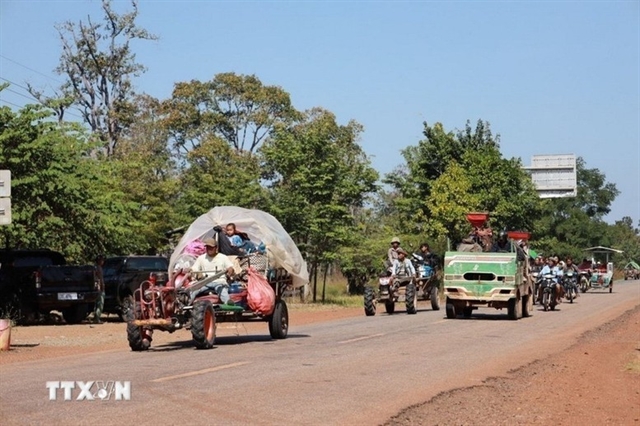 Society
Society


|
| Close contacts of COVID-19 positive cases in Thanh Xuân Trung District of Hà Nội were moved into centralised quarantine in August 2021. — VNA/VNS Photo Tuấn Anh |
HÀ NỘI — Hà Nội authorities have allowed home quarantine for F1 cases (having direct contacts with COVID-19 patients) in all areas except for four inner districts of Ba Đình, Hoàn Kiếm, Đống Đa and Hai Bà Trưng.
In the latest instruction signed by vice chairman of the municipal People’s Committee, Chử Xuân Dũng, the authorities require quarantine areas to be separate houses or apartments with warning signs at the front gates. Yellow waste baskets labeled infection waste are required to store discarded personal protective equipment from medical staff.
F1 cases must be isolated in enclosed rooms which are separate from the family living areas. The installation of cameras is encouraged to monitor quarantined people.
The isolation room must have a separate toilet and bathroom, enough personal hygiene tools, hand soap, clean water, and hand sanitiser containing at least 60 per cent alcohol and personal temperature measuring device.
The city’s authorities order not using air conditioners connected with other areas and encourage separate air conditioners.
The isolation rooms must be equipped with washing machines or buckets for the quarantined people to wash clothes by themselves.
Quarantined people must strictly observe the quarantine period, are not allowed to leave their rooms and interact with other family members or pets during the time.
F1 cases are asked to self measure their temperatures, follow health status and update reports daily. If there are any suspected infection signs like coughing, fever, sore throat, shortness of breath, they must immediately alert medical staff.
They must conduct testing at least three times on the first day of quarantine and other tests on the seventh and fourteenth days of quarantine.
Elderly members or those infected with chronic diseases must not have contact with quarantined people.
All family members must conduct group testing at least three times on the first day of quarantine and other tests on the seventh and fourteenth days.
Local authorities have been asked to only allow home quarantine when households meet requirements and supply essential items for households that have quarantined people.
Vice chairman of the municipal People’s Committee Nguyễn Văn Phong on Saturday said the city’s authorities had assigned the local Department of Health and relevant agencies to map out a scenario of 100,000 COVID-19 cases given the increasing infection risk in the New Year holidays.
If the city reports 30,000 cases or more, there will be four levels of treatment with the first level at city’s hospitals, the second level at district’s hospitals, the third at commune/ward healthcare centres and the fourth level, in case of overload, at home, he said.
The city’s authorities have assigned the Department of Health to study piloting home treatment for positive cases with light symptoms, he said.
According to the municipal Department of Health, nearly 8,000 F1 cases and those who entered the cities from other areas are currently in quarantine. The district authorities have reviewed and compiled a list of quarantine areas to accommodate 100,000 cases.
All 30 districts and towns have approved a plan to set up mobile health stations. Each village or residential group is expected to arrange one venue in response to any arising scenario.
As of November 19, the city has remained its second risk level (medium risk). Four districts of Hoàn Kiếm, Ba Vì, Đan Phượng, Ứng Hòa are at the first risk level (low risk); 26 districts and towns are at the second level.
Three communes and wards are at the third level (high risk) and no area is at the very high risk level.
Shortening centralised quarantine period
The HCM City’s Department of Health has sought the health ministry’s permission to pilot shortening centralised quarantine period for F0 cases.
If patients in HCM City have no or light symptoms with symptoms disappearing after one week, the city’s health department proposed shortening quarantine period at centralised sites from 14 days to seven days for those who have no symptoms, have been fully vaccinated and test negative on the seventh day of quarantine.
The move aims to reduce overcrowding at centralised quarantine areas amid rising cases despite high vaccination rates in the epicentre of the country's fourth wave of infections. — VNS




